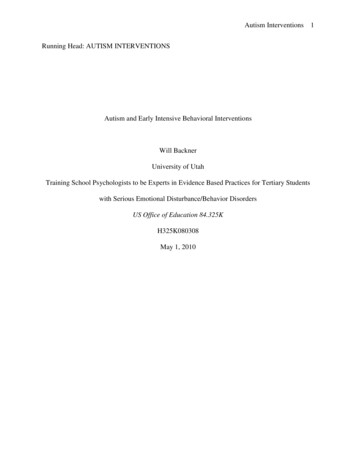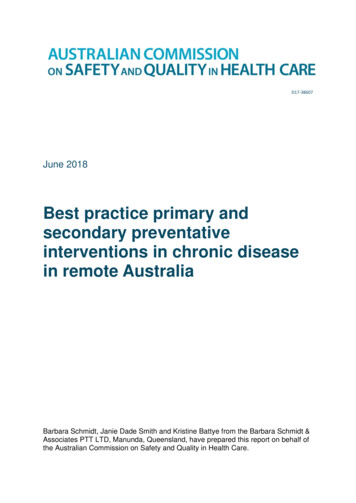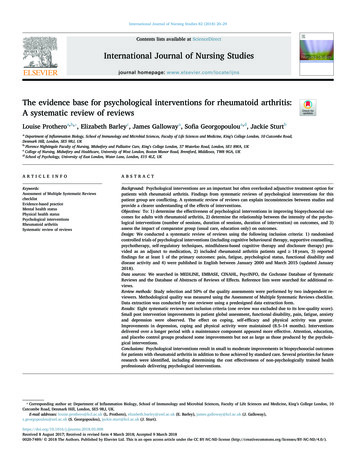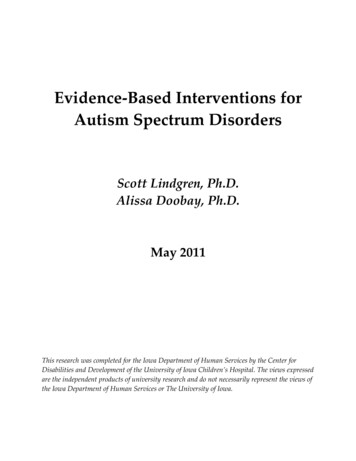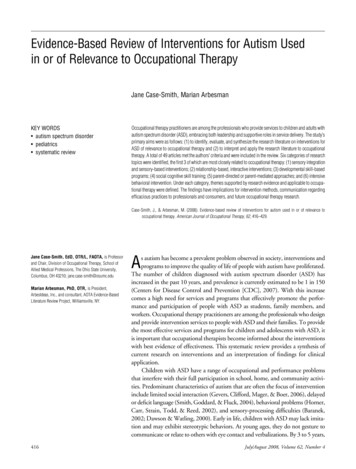
Transcription
Evidence-Based Review of Interventions for Autism Usedin or of Relevance to Occupational TherapyJane Case-Smith, Marian ArbesmanKEY WORDS autism spectrum disorder pediatrics systematic reviewOccupational therapy practitioners are among the professionals who provide services to children and adults withautism spectrum disorder (ASD), embracing both leadership and supportive roles in service delivery. The study’sprimary aims were as follows: (1) to identify, evaluate, and synthesize the research literature on interventions forASD of relevance to occupational therapy and (2) to interpret and apply the research literature to occupationaltherapy. A total of 49 articles met the authors’ criteria and were included in the review. Six categories of researchtopics were identified, the first 3 of which are most closely related to occupational therapy: (1) sensory integrationand sensory-based interventions; (2) relationship-based, interactive interventions; (3) developmental skill-basedprograms; (4) social cognitive skill training; (5) parent-directed or parent-mediated approaches; and (6) intensivebehavioral intervention. Under each category, themes supported by research evidence and applicable to occupational therapy were defined. The findings have implications for intervention methods, communication regardingefficacious practices to professionals and consumers, and future occupational therapy research.Case-Smith, J., & Arbesman, M. (2008). Evidence-based review of interventions for autism used in or of relevance tooccupational therapy. American Journal of Occupational Therapy, 62, 416–429.Jane Case-Smith, EdD, OTR/L, FAOTA, is Professorand Chair, Division of Occupational Therapy, School ofAllied Medical Professions, The Ohio State University,Columbus, OH 43210; jane.case-smith@osumc.eduMarian Arbesman, PhD, OTR, is President,ArbesIdeas, Inc., and consultant, AOTA Evidence-BasedLiterature Review Project, Williamsville, NY.416As autism has become a prevalent problem observed in society, interventions andprograms to improve the quality of life of people with autism have proliferated.The number of children diagnosed with autism spectrum disorder (ASD) hasincreased in the past 10 years, and prevalence is currently estimated to be 1 in 150(Centers for Disease Control and Prevention [CDC], 2007). With this increasecomes a high need for services and programs that effectively promote the performance and participation of people with ASD as students, family members, andworkers. Occupational therapy practitioners are among the professionals who designand provide intervention services to people with ASD and their families. To providethe most effective services and programs for children and adolescents with ASD, itis important that occupational therapists become informed about the interventionswith best evidence of effectiveness. This systematic review provides a synthesis ofcurrent research on interventions and an interpretation of findings for clinicalapplication.Children with ASD have a range of occupational and performance problemsthat interfere with their full participation in school, home, and community activities. Predominant characteristics of autism that are often the focus of interventioninclude limited social interaction (Gevers, Clifford, Mager, & Boer, 2006), delayedor deficit language (Smith, Goddard, & Fluck, 2004), behavioral problems (Horner,Carr, Strain, Todd, & Reed, 2002), and sensory-processing difficulties (Baranek,2002; Dawson & Watling, 2000). Early in life, children with ASD may lack imitation and may exhibit stereotypic behaviors. At young ages, they do not gesture tocommunicate or relate to others with eye contact and verbalizations. By 3 to 5 years,July/August 2008, Volume 62, Number 4
children with ASD may not have developed language or mayhave limited speech; many use words but not with communicative intent. Important aspects of social emotional functioning, such as reading facial expressions, understandinggestures and nonverbal communication, recognizing inflection, and using language, are delayed or deficit (Dawson &Galpert, 1990). The social play of children with ASD issubstantially limited, lacking joint attention, creativity, andpretend scenarios. Greenspan and Wieder (1997) describedabsent joyful interactions and engagement that reflects interest in and attachment to others.Most children with ASD have sensory-processing disorders. Although visual–spatial skills may be more advanced,other sensory responses, such as those to touch and auditoryinput, suggest poor modulation. Greenspan and Wieder(1997) estimated that 39% of children with ASD are underreactive to sensation, 20% are hypersensitive, and 36% showa mixed pattern of hypersensitivity and hyposensitivity.These children often have aversions to olfactory and gustatory sensations and, as a result, may be highly restrictive inwhat they eat. Baranek (2002) also documented that manychildren with ASD demonstrate unusual sensory responses(e.g., hyporesponses and hyperresponses) to touch and auditory stimulations. These underlying impairments create barriers to their ability to develop social relationships, functionin everyday environments (such as the classroom or playground), and learn social rules.Given this breadth and depth of performance limitations, children and adolescents with ASD need a range ofinterventions and educational programming. In young children with ASD, occupational therapists often focus onenhancing children’s sensory processing, sensorimotor performance, social–behavioral performance, self-care, and participation in play. In older children and adolescents, occupational therapy goals may focus on social and behavioralperformance, transition to work, and independence in thecommunity. In most settings, occupational therapists aremembers of an interdisciplinary team of professionals whoevaluate, plan, and implement the child’s program. Thissystematic review of the research literature considers therange of problems exhibited by people with ASD and therange of intervention approaches that can be or are used byoccupational therapy practitioners. It considers both thedirect service roles and supportive team roles that occupational therapy practitioners demonstrate.MethodsThis study was initiated and supported by the AOTA as partof the Evidence-Based Literature Review project. The goalof the project is to promote evidence-based practice throughThe American Journal of Occupational Therapya variety of dissemination efforts, including publication ofthe results of systematic reviews in peer-reviewed journals. Afocused review question was developed by the authors andreviewed by an advisory group of experts in ASD. Accordingto the consensus of the group, for the purposes of the review,the definition of ASD included autism, Asperger’s disorder,and pervasive developmental disorder. Search strategies wereto include occupation and engagement in addition toperformance-based interventions. The role of family, familycoping, behavior, self-regulation, and the contextual components of intervention were also to be included in thesearch. In addition, there was consensus that multicomponent, multidisciplinary programs as well as focused programsthat are adjunctive to broader behavioral interventionsshould be included in the review.The authors, in conjunction with a medical librarianwith experience in evidence-based reviews, selected researchreports of relevance to occupational therapy, analyzed andsummarized the reports, and interpreted the information foroccupational therapy practice.Research QuestionThe following research question guided selection of researchstudies for the review and interpretation of the findings: What is the evidence for the effect of interventions usedin or of relevance to occupational therapy in children andadolescents with autism spectrum disorder?ProceduresA broad search was undertaken to identify research reportsfor the review. Databases and sites searched includedMedline, CINAHL, ERIC, PsycINFO, Social SciencesAbstracts, Sociological Abstracts, Linguistics and LanguageBehavior Abstracts, RehabData, Latin American andCaribbean Health Sciences Literature, and EBSCOHost. Inaddition, consolidated information sources, such as theCochrane Database of Systematic Reviews and the CampbellCollaboration, were included in the search. These databasesare peer-reviewed summaries of journal articles and providea system for clinicians and scientists to conduct evidencebased reviews of selected clinical questions and topics.Search terms were developed by the authors andreviewed by the advisory group (Table 1). Articles wereincluded in the review if they provided evidence for anintervention approach used with children or adolescentswith ASD, had been peer reviewed, were published between1986 and 2007, and addressed a performance area or intervention approach within the domain of occupational therapy. Only studies determined to be Level I (i.e., randomized controlled trials, systematic reviews, and meta-analyses),Level II (i.e., nonrandomized clinical trials such as cohort417
Table 1. Search Terms Used to Identify Research ReportsCategoryKey Search TermsSample/client populationautism (excluding Rett’s syndrome and childhood disintegrative disorder), autism spectrum disorder, Asperger syndrome, pervasivedevelopmental disorderInterventionoccupational therapy, sensory integration, touch pressure, massage, therapeutic listening, auditory integration training, play, activitiesof daily living, social participation, assistive technology, augmentative communication, neuromotor, peer mediated, social stories, perceptual motor learning, behavior intervention, applied behavioral analysis, discrete trial training, comprehensive, developmental,Treatment and Education of Autistic and Communication Handicapped Children (TEACCH), relationship-based interventions, friendship, job training, peer group, peer interaction, self-care, instrumental activities of daily living, antisocial behavior, adaptive behavior,cooperative behaviors, social skills training, family coping, coping skills, social competence, problem solving, decision-making skills,token economy, activity groupsOutcomesself-care, education, transition to work and community, play, leisure, social participation, communication, affect, behaviorstudies), and Level III evidence (i.e., before–after, onegroup designs) were included. Research reports wereexcluded if they were published before 1986, were Level IVor V evidence (descriptive studies that include analysis ofoutcomes, such as case series and single-subject design, andcase reports and expert opinion, such as narrative literaturereviews and consensus statements), used qualitative methods to the exclusion of quantitative methods, were not peerreviewed, or had serious design limitations. Of the 17,440citations reviewed, 217 articles appeared to have relevanceto occupational therapy and were selected to determinewhether they fit the criteria. The first author, the AOTAconsultant, and AOTA staff made the final selection of thestudies using the established criteria.The first author analyzed the studies (n 49) by describing and evaluating the study level, study design, number ofparticipants, types of interventions and outcome measures,summary of results, study limitations, and implications ofthe study for occupational therapy. Guidelines for reviewingquantitative studies were based on those developed by Law(2002) to ensure that the evidence was ranked according touniform definitions of research design elements. An evidencetable that included interpretation of findings for occupational therapists was created and reviewed by both authors.Among the 49 studies, 18 were Level I, 17 were Level II, and14 were Level III evidence. This systematic review presentsa synthesis of the findings.ResultsThe results were organized by the autism interventionapproaches represented in the literature. The studies werecategorized into the following topics: (1) sensory integrationand sensory-based interventions, (2) relationship-based,interactive interventions, (3) developmental skill–based programs, (4) social–cognitive skill training, (5) parent-directedor parent-mediated approaches, and (6) intensive behavioralintervention. These categories were ordered by those inter418ventions most likely to be directly used by occupationaltherapists to those of relevance to their supportive team roles.Across the studies, certain themes consistently emerged, suggesting their importance to clinical practice; the themes arepresented in italic type.Sensory Integration and Sensory-Based InterventionsOccupational therapists frequently focus on sensory-processingproblems in children with ASD. Although occupationaltherapists clearly have expertise in sensory integration andsensory-based interventions (Bundy, Lane, & Murray,2002), occupational therapy studies of the effects of sensoryintegration approaches with children with autism are few(see Baranek, 2002, for a review). Interventions focused onsensory processing can be categorized as sensory integration,sensory-based interventions (e.g., massage, brushing), andauditory integration training (which is similar to therapeuticlistening used by occupational therapists). Of the 8 studiesidentified, all were Level I; 5 examined auditory integrationtraining, 2 investigated the effects of massage, and 1 was asystematic review of sensorimotor interventions.Sensory integration intervention appears to enhance thechild’s ability to modulate behavior and participate in socialinteraction; however, findings are inconclusive at this time(Baranek, 2002). One goal of sensory integration interventionis to improve the child’s ability to modulate arousal, resultingin well-organized, adaptive responses. In her systematic reviewof sensory and motor intervention for children with autism,Baranek (2002) identified Level III and IV studies of sensoryintegration intervention with children with autism (Ayres &Tickle, 1980; Case-Smith & Bryan, 1999; Linderman &Stewart, 1999). In these studies of young children with ASD,sensory integration intervention was associated with positivechanges in social interaction, purposeful play, and decreasedsensitivity. Limitations of the studies included small samplesize and lack of control groups. Although each of these studieshad positive findings, when combined, the evidence remainsweak and requires further study.July/August 2008, Volume 62, Number 4
Sensory-based interventions, such as those that providetherapeutic touch, can decrease maladaptive behaviors, reducehyperactivity, inhibit self-stimulation and stereotypic movements, and improve attention and focus (Escalona, Field,Singer-Strunck, Cullen, & Hartshorn, 2001; Field et al.,1997). One sensory technique, massage, when implementeddaily, can improve attention and reduce stereotypic behaviors. Two randomized controlled trials (Level I evidence)investigated the effects of massage on children with ASD(Escalona et al., 2001; Field et al., 1997). Field et al. (1997)compared a group of boys with autism who received massagefor 4 weeks (2 days per week) to boys with autism whoplayed a game for the same amount of time. The boys whoreceived massage exhibited decreased aversion to touch, offtask behavior, and stereotypic behavior. Limitations of thestudy included lack of standardized measures and short-termintervention. In a similar study, Escalona et al. (2001) compared children with ASD who received massage administeredby their parents every night for a month to a comparisongroup whose parents read to them every night. The childrenwho received massage demonstrated reduced hyperactivity,decreased impulsivity and stereotypical behaviors, andimproved on-task behaviors. The researchers attributed thepositive findings to improved sleep after massage.Therapy approaches that use the auditory system (i.e., therapeutic listening and auditory integration training) to promoteintegration and organization of the central nervous system haveinconclusive evidence for their effectiveness (Sinha, Silove,Wheeler, & Williams, 2004). Five Level I studies of auditoryintegration training (AIT) have examined the effects onpeople with ASD (Bettison, 1996; Edelson et al., 1999;Mudford et al., 2000; Sinha et al., 2004; Zollweg, Palm, &Vance, 1997). AIT provides the basis for therapeutic listening programs (e.g., Frick & Hacker, 2001) that are used inoccupational therapy. In AIT, children listen to modulatedmusic through headphones several times a day for 10 ormore consecutive days. In all of the AIT studies, the children’s behavior improved (i.e., aberrant behaviors decrease);however, listening to modulated music was no more effectivethan unmodulated music. Results of these studies indicatethat listening to music through headphones can improveproblem behavior. Positive results specific to AIT were demonstrated in one long-term randomized clinical trial byEdelson et al. (1999). These investigators found that participants who received the AIT improved more in aberrantbehaviors, sound sensitivity, and eye contact (by report oftheir parents). In a recent Cochrane systematic review ofAIT, Sinha et al. (2004) synthesized the research literatureof AIT for people with ASD. They found that the evidencefor AIT effectiveness was weak and inconclusive. Giveninconclusive evidence, occupational therapy practitionersThe American Journal of Occupational Therapyshould closely monitor the child’s behaviors when usingtherapeutic listening or AIT to determine individual effectson the child.Most scholars recommend use of sensory-based interventionsas one component of a comprehensive intervention that uses avariety of methods to promote performance (Baranek, 2002;Greenspan & Wieder, 1997). Although some positive benefitsfrom sensory-based treatment have been documented, it isnot clear how these interventions promote the child’s overallfunctional and educational outcomes (Baranek, 2002).Sensory-based interventions, including modifying the sensory environment, appear to be most effective when childrenexhibit sensory-processing deficits with problems in arousal,attention, or behavior. Scholars recommend that occupational therapists pair sensory-based interventions with functional tasks in which the child practices the targeted performance outcome (Baranek, 2002; Mailloux & Roley, 2004;Parham & Mailloux, 2005). Additional study is needed todetermine whether effects are sustained and generalized todifferent skill sets. Future research studies should includemeasurement of both physiological and performance effectsto determine the mechanisms through which sensory-basedinterventions influence behavioral and performanceoutcomes.Relationship-Based, Interactive InterventionsOccupational therapy practitioners often combine sensoryintegration intervention with interactive play activities individually designed to enhance the child’s play and social participation. These interactional or relationship-based interventions focus on improving social–emotional growth in childrenwith ASD and match the philosophy of occupational therapists. Eleven research reports (2 Level I, 2 Level II, and 7Level III) investigated the effects of relationship-based interventions. These studies included parents, peers, and therapists in interactive play-based activities and examined socialcompetence and social engagement outcomes. Effects of theseinterventions were positive, but small.Relationship-based interventions (e.g., Hwang & Hughes,2000) that use adult imitation of the child’s actions, implementhigh levels of positive responsiveness, apply prompting and cueing, facilitate peer interactions, establish environments that support social interaction, and demonstrate positive effects on socialengagement in children with ASD. Hwang and Hughes (2000)completed a comparative review to examine the effects ofnaturalistic social interactive interventions on increasingchildren’s social communicative skills, particularly their initiation of social interactions. The focus of this review wasresearch on naturalistic interventions such as contingentimitation, naturally occurring reinforcement, and arrangement of the environment to increase the child’s interest in419
activities. The outcomes examined were social behavior suchas requesting assistance, greetings, eye gaze, joint attention,and imitation. This analysis of 16 studies identified specificstrategies, many of which can be used by occupational therapy practitioners, that demonstrate evidence of effectiveness.Several of the studies in the review reported generalizationof skills and maintenance of positive findings. One findingwas that waiting for a child to respond (i.e., pausing beforecueing again) increased children’s verbal responses and participation in conversation. Arranging the environment topresent challenges to the child (e.g., placing favorite toy onhigh shelf) increased communication attempts. Imitating thechild drew in his eye gaze and resulted in positive affect andattending. Hwang and Hughes (2000) identified adult imitation of the child’s actions as an effective strategy to promotethe child’s participation in interactive play.In a randomized clinical trial (Field, Field, Sanders, &Nadel, 2001) of 20 children with autism, the children whoseactions were imitated were more focused in their play anddemonstrated more interactive behaviors. A Level III study(Dawson & Galpert, 1990) also examined the effects ofmother’s imitation of her child’s play. Although the children’s gaze to mother and the number of play schemesincreased, vocalization and positive affect did not change.Both studies of adult imitation of the child were short term(three sessions or 2 weeks), and only short-term effects weremeasured.Structured play activities, such as block construction orgames that include cueing, prompting, and reinforcement, areeffective interventions to enhance turn-taking, sharing, communication, and social interaction in children with ASD(Legoff, 2004). Several studies examined the effects of socialgames and play activities with peers on children’s development of social interaction skills, communication, and playdevelopment (Legoff, 2004; Legoff & Sherman, 2006;Schleien, Mustonen, & Rynders, 1995). Legoff completed2 studies (Level II) that examined the effects of Lego therapyon social competence in children with ASD. The intervention studied was similar to occupational therapy activitygroups in that children played with Legos and followedsimple social rules, the focus was cooperative play and fun,peers and aides facilitated the play, members participated injoint decisions, and family support was included. Legos wereselected because children with autism often have an affinityfor constructing with blocks and appear to prefer structuredactivities to creative or pretend play. Building a large structure automatically requires cooperation and social interaction. By establishing social rules, encouraging interactionand sharing, and facilitating problem solving, children madegains in social interaction and social competence. The intervention had positive effects, including a 175% increase in420the duration of social interaction with peers during free play(Legoff, 2004).In the follow-up study (Legoff & Sherman, 2006), inwhich a matched sample of children was compared with thegroup who participated in Lego therapy for a 3-year period,the Lego therapy group exhibited higher social interaction.These studies suggest that consistency and sameness in activities may allow children with autism to focus on social interaction and cooperation. Importantly, the elements of theplay groups, that is, rules for cooperation, selection of materials of high interest, facilitation of sharing and turn-taking,support of families and peers, appeared to be critical to thepositive results.Two other Level III studies of activity-based intervention, art activities (Schleien, Mustonen, & Rynders, 1995)and play sessions in a gym (Schleinen, Mustonen, Rynders,& Fox, 1990), were similar to occupational therapy in thatthey used a specific activity to encourage cooperation andpositive interaction in children with ASD. These studiesdemonstrated the importance of typical peer models in promoting social interactions in children with ASD.Intervention emphasizing responsive, supportive relationships, and social–emotional development in young children canfacilitate the child’s social–emotional growth and promote development of pivotal behaviors essential for learning (Greenspan& Wieder, 1997; Mahoney & Perales, 2005; Wieder &Greenspan, 2005). In these Level III studies, parental responsiveness and sensitivity to the child’s communicationattempts created a foundation for the child’s developmentalgrowth. Greenspan and Wieder (1997) completed a chartreview of 200 children who had participated in relationshipbased floor-time therapy with their parents and comprehensive interdisciplinary interventions. After 2 to 3 years ofintervention, they found that 58% of the child outcomeswere good to outstanding, 25% were medium, and 17%were limited. Wieder and Greenspan (2005) reported a follow-up of 16 of the children whose initial outcomes hadbeen good to outstanding. These children were evaluated 10to 15 years after they had participated in a 2 or more yearperiod of relationship-based (floor time) intervention. Thechildren with optimal outcomes had become socially competent, responsive, and interactive; they exhibited somemental illness (depression and anxiety), but the primarycharacteristics of autism were no longer evident.Mahoney and Perales (2005) completed a one-group preand postassessment study measuring the effects of relationshipfocused intervention on young children with pervasive developmental disorders that encouraged parents (primarilymothers) to increase their responsive to their children. As inthe Greenspan and Wieder studies (Greenspan & Wieder,1997; Wieder & Greenspan, 2005), a primary focus of theJuly/August 2008, Volume 62, Number 4
intervention was to guide parents to develop positive interactional skills, that is, responsiveness and sensitivity to theirchild. After a year of the relationship-focused intervention,mothers made significant increases in responsiveness and children made significant gains in socioemotional functioning(Mahoney & Perales, 2005). These studies suggest that occupational therapists embrace parents within their interventionand coach them in methods that promote their child’s socioemotional growth. Coaching models and interventions thatfocus on playful turn-taking have been described in the occupational therapy literature for many years (Hanft, Rush, &Shelden, 2004; Knox, 2005). Studies by Greenspan andWieder (1997; Wieder & Greenspan, 2005) suggested thatrelationship-focused intervention are effective when workingwith young children who appear relatively high on the spectrum and parents who appear to have the resources and energyto become intensely involved in the intervention activities.Developmental Skill-Based ProgramsComprehensive programs for young children with autismtypically use developmental-based instructional models thatinclude occupational therapy services. These programs are playbased, use peers, focus on strengths of the child, and involveprofessionals from multiple disciplines (Audet, Mann, &Miller-Kuhaneck, 2004). Two prominent programs that usea developmental and comprehensive approach are the DenverModel, developed by Sally Rogers (Rogers & DiLalla, 1991),and Treatment and Education of Autistic and CommunicationHandicapped Children (TEACCH), originally developed bySchopler and Reichler (1971). Six studies (4 Level II, and 2Level III) examined these programs or similar programs.Programs that emphasize a developmental, play-basedapproach that emphasizes positive affect, nonverbal communication play, social relationships, and classroom structure have smallpositive effects (Rogers, Herbison, Lewis, Pantone, & Rels, 1986).In a Level III descriptive study using one group of youngchildren with ASD, Rogers et al. (1986) measured play anddevelopment skill before and after a 6-month preschool program. The 26 children who participated demonstrated positive changes in cognition, communication, and social emotional skills beyond their developmental trajectory. Althoughthe results were significant, lack of a comparison group orcontrol condition is a serious limitation. In a second Level IIIstudy, Rogers and DiLalla (1991) completed a retrospectiveanalysis of children’s change in developmental rate before andafter 8 to 12 months of intervention. During this intervention period, the children improved more than was expectedin all developmental areas (in a 10-month period, the children with ASD made almost a 10-month developmental gainin language). This comprehensive program appears beneficial;however, more rigorous trials are needed.The American Journal of Occupational TherapyChildren with ASD often have strengths in visual perception (particularly of inanimate objects). Interventions that usevisual cueing and visual learning are effective in promotingcommunication and learning (Ozonoff & Cathcart, 1998;Panerai, Ferrante, & Zingale, 2002). One such program,TEACCH, was developed in the 1960s and has been widelydisseminated (Schopler, Mesibov, & Baker, 1982). As notedby Watling (2004), strategies from TEACCH, such as useof visual schedules, fit easily in the intervention strategies ofthe occupational therapist. The program can be implementedby parents with support from professionals or may be implemented primarily in the classroom. The focus is a structuredteaching environment that visually cues the child with anemphasis on alternative communication systems, generallyusing pictures or photographs and visual cueing (Watling,2004). Ozonoff and Cathcart (1998) examined the effectsof a TEACCH-based home program in a Level II nonrandomized tri
occupational therapy. American Journal of Occupational Therapy, 62, 416-429. Jane Case-Smith, Marian Arbesman As autism has become a prevalent problem observed in society, interventions and programs to improve the quality of life of people with autism have proliferated. The number of children diagnosed with autism spectrum disorder (ASD) has
